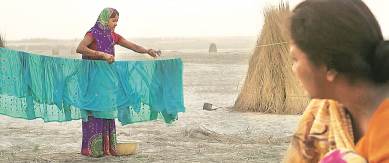Click here to follow Screen Digital on YouTube and stay updated with the latest from the world of cinema.

Main chamaro ki gali tak le chalunga aapko, Ayiye mehsoos kijiye zindagi ke taap ko
A couple of years ago, he decided to translate the present conditions of Dalit communities in his film Life of an Outcast (2018), which was recently screened in the Capital. The film is about a poor Dalit farmer and his educated son, a Mathematics teacher in the local school. When his son gets arrested for not writing ‘Om’ on the blackboard before beginning his lessons and highlighting that he is a Mathematics teacher and not a religious scholar, the farmer, who has to live outside the village because he is a Dalit, goes to the city everyday to earn Rs 500 per day for his son’s bail. While the son speaks of his rights, BR Ambedkar and the Constitution in the police station, his father knows only of hard work and believes that the poor have no caste and that only money can save them. “The way Dalits have been excluded from our developmental policies, politically and socially, and how the number of atrocities has increased manifold in the past few years, affects how I think of my stories. The dichotomy in the thinking of a father and son is the basis here,” says Shrivastava.
Inspired by the world of social media, the film also has the character of a chaiwala in the film, who talks of Trump and his ‘model’ wife, considers PM Modi to be like him, ‘a chaiwala’, and keeps talking without any concern for the stories and struggles of those at his shop. “That’s my take on Fake News and the world of propaganda that it builds around us. The chaiwala in the film is an embodiment of that,” says Shrivastava, about his film, which is a crowdfunded venture. Shrivastava went to filmmaker Onir for advice. “He’d also crowdfunded I Am. I thought I could too,” he says.
The filmmaker also felt that many new, independent filmmakers are making films on urban subjects. “But, rural India is completely excluded. Films on Dalit issues are definitely not on the agenda. I only remember Sairat and Fandry, two films out of thousands. Production houses like UTV and Eros are only creating films for the multiplex audience. But I was keen on showcasing a world that doesn’t make it to the reel very often. Since we don’t know that this world exists, we lose compassion for its people. We hardly ever get to know when farmers protest at Jantar Mantar,” he says.
Read the interview in Malayalam
Shrivastava grew up watching Guru Dutt films with his father and decided to be a filmmaker early on. “I’d see people sitting under a tree and talking or eating, which is the life in a small town, and felt an inherent need to capture this on film and show it to those who don’t know about the rural life and its landscapes,” says Shrivastava, a computer science graduate, whose first film was Naya Pata (2014), in Bhojpuri, and the first to find a PVR release. With the backdrop of the sugar industry, the film explored migration. The film was crowdfunded and made with Rs 12 lakh. “When I went to see the film, the poster was right next to Gunday’s, on which crores were spent. That assured me that good cinema will reach the theatres,” says Shrivastava, who has also directed 200 street plays.
Click here to follow Screen Digital on YouTube and stay updated with the latest from the world of cinema.